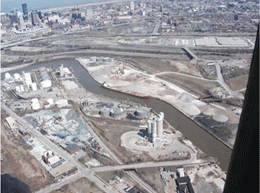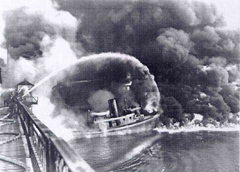Putting out the Cuyahoga
Air Date: Week of June 19, 2009

The Cuyahoga River runs through the industrial zone of Cleveland, Ohio. Engineers have straightened and dredged the river to make it easier for ships to get through. (Courtesy of EPA)
Forty years ago this month, the Cuyahoga River in Cleveland became the poster child for the problem of industrial pollution on American rivers. A Time Magazine article reported the local joke that if a person fell in the river they would not drown, but decay. That article sparked outrage in the American public and jumpstarted the environmental movement and the Clean Water Act. Host Jeff Young talks with Frank Samsel who spent his career cleaning up the Cuyahoga.
Transcript
[MUSIC: Randy Newman “Burn On” from Sail Away Remastered (Earner Bros. 2005)]
YOUNG: This month marks the 40th anniversary of a watershed moment in environmental history: June 22, 1969 the Cuyahoga River caught fire in Cleveland.
It was hardly an isolated event. The Cuyahoga was so heavily and chronically contaminated it burned at least a dozen times. Riverboat pilot Wayne Bratton recalls seeing the river in flames in the mid 70s.

Firefighters struggle to extinguish a fire on the Cuyahoga River in 1952. (Courtesy of NOAA)
YOUNG: Locals were a bit blase about the burning river, but national media attention sparked outcry over the sad state of our rivers and lakes. That helped give rise to the US Environmental Protection Agency and landmark laws like the Clean Water Act. Those laws and agencies are largely credited with cleaning up our rivers.
But on the Cuyahoga, the actual work of cleaning was up to people like Frank Samsel. Samsel spent much of his life on the Cuyahoga aboard a boat he designed called the Putzfrau, a very special vessel that lived up to its name.
SAMSEL: Putzfrau, itÂ’s kind of German for cleaning lady. And the function of the boat was to clean up floating debris and oil on the river. On the front of the boat is a vacuum and it picks up small debris and oil off the surface of the water. And because oil is kind of tenacious, you know, it has a tendency to cause things to kinda of glom together. Where the current slowed down in the navigable channel, it collected debris into very large mats, maybe an acre and a half or two acres on the surface.
YOUNG: Wow.
SAMSEL: And weÂ’d go in and weÂ’d clean this stuff up.
YOUNG: What was an average day? How much junk would you pick up off the river?
SAMSEL: In about sixteen hours, we could pick up about 100 cubic yards of debris and about 15,000 gallons of oil. And you gotta realize that at that time we were in a different economy. Black oil, at that time, number six, was 3 cents a gallon, you know.
YOUNG: So, if you spilled a little it wasnÂ’t that big a deal.
SAMSEL: Well, itÂ’s cheaper to spill it than to spend the time on labor on back flushing and cleaning and, you know, so you spill a barrel of oil. So what, you know. You lost two dollars, maybe.
YOUNG: Right.
SAMSEL: Big deal, you know. You put that against five men’s labor fiddling around for forty-five minutes. It’s cost effective to do that. You know, that was an obvious polluter. At one time we walked around the gasoline - we had six buckle boots on – we were walking in gasoline up to our ankles. And you know you’re really concerned because one spark or something like that and you’re toast.

The Cuyahoga River in Ohio runs through Cleveland to empty into Lake Erie.
SAMSEL: Yes. Industry got the bad name, but as Pogo says, you know, we have met the enemy and he is us.
YOUNG: Uh-huh.
SAMSEL: Well thatÂ’s what we found out. We found out that weÂ’re putting raw sewage into the river.
YOUNG: Describe for us what the Cuyahoga was like in say late 60s early 70s. Just paint us a picture of that river.
SAMSEL: Well about this time of the year would start, the river would go completely anaerobic, no oxygen, none whatsoever. And it would start to percolate, it would bubble. The sewage – it was like a gigantic catch basin or a septic tank. And it would just collect this stuff. And it stunk to high heaven. We had a river that had a lot of floating debris on it because there was a time when that’s where you threw your grass clippings, that’s where all the stuff goes, you throw it in the river and it goes away and you don’t worry about it. And I’m talking about the public as well as private industry. They’d throw whatever – and don’t forget we had a big plating industry. And that the pickle tanks that they would pickle stuff in and the other tanks would have to be flushed out occasionally. You know these forty, fifty thousand gallon tanks would be dumped into the river and it would make a great huge black blob in one spot and you could see it move down the river as the current moved it down. So no matter who told you how bad it was, at that time, they weren’t exaggerating. It was bad. Chemical companies would throw their stuff in there so you might have a coat of acid on top. We had a supply business, fellows would come down occasionally and one guy came down once and he said “we’ve got this coating, it’s really marvelous.” And I said “well, let me try it out”. So he had a sample on a piece of tin. And I put a piece of wire on it and I hung it in the river. And I said, well you could back in ten days, and we’ll see what this coating’s like. And he says, “this is a marvelous thing”. So ten days later he came back, I pulled the piece of tin out of the river, and took my finger nail and a scraped the coating off the metal. And I said, “well you need a little work on this yet.”
[LAUGHING]
YOUNG: You were like the proving ground for these thingsÂ…
SAMSEL: Well for that particular individual, yeah, and he couldn’t believe it. We had a launch that we would service the oar fleet* with and I said “You know, see the launch? There’s no paint from the water line down. And there’s no rust. The acid and the chemicals, they took the paint off and the oil coats it. I said we don’t have rust on the outside of the boat and we don’t have paint because nothing sticks to it. You could bring a salt water vessel in there and all the barnacle would drop off [laughing] because ….
YOUNG: Wow.
SAMSEL: It did the trick.
YOUNG: Well thatÂ’s a pretty vivid image. I mean the picture youÂ’re painting for me here is a bubbling lifeless cesspool covered with chemicals and oil and debris.
SAMSEL: That stunk.
YOUNG: That stunk. LetÂ’s not forget stinking.
SAMSEL: You canÂ’t emphasize that enough. I mean it was horrible.
YOUNG: So that was the Cuyahoga then.
SAMSEL: Yeah.
YOUNG: Now describe the Cuyahoga for me today.
SAMSEL: ItÂ’s really, itÂ’s turned around. If you know where to go in the Cuyahoga River youÂ’ve got some of the finest steelhead fishing there is. YouÂ’ve got some of the finest bass fishing there is. In the summer, of course, now we have tremendous walleye fishing. People say itÂ’s the walleye capitol of the world. WeÂ’ve got people coming from Minnesota and Wisconsin and Michigan down here to fish in Lake Erie.

(Courtesy of EPA)
SAMSEL: You could imagine it, but you wouldn’t think that it would happen this quick, because it was so bad, that you’d say “well they’ll probably clean it up, but not in my lifetime.” And the changes have been really tremendous. You like to brag about it, but still, we’d like to keep the fishing for ourself.
[LAUGHING]
SAMSEL: We donÂ’t want people coming from everywhere.
YOUNG: So donÂ’t tell everybody. I wonÂ’t tell everybody, okay?
SAMSEL: Okay. WeÂ’ll keep it between ourselves.
YOUNG: Well Frank Samsel has been talking with us about cleaning up the Cuyahoga River, and Mr. Samsel, I hope you get lots of opportunities to enjoy the fruit of your labor and get out there and do lots of fishing.
SAMSEL: Thank you very much and goodbye now.
Links
Living on Earth wants to hear from you!
Living on Earth
62 Calef Highway, Suite 212
Lee, NH 03861
Telephone: 617-287-4121
E-mail: comments@loe.org
Newsletter [Click here]
Donate to Living on Earth!
Living on Earth is an independent media program and relies entirely on contributions from listeners and institutions supporting public service. Please donate now to preserve an independent environmental voice.
NewsletterLiving on Earth offers a weekly delivery of the show's rundown to your mailbox. Sign up for our newsletter today!
 Sailors For The Sea: Be the change you want to sea.
Sailors For The Sea: Be the change you want to sea.
 The Grantham Foundation for the Protection of the Environment: Committed to protecting and improving the health of the global environment.
The Grantham Foundation for the Protection of the Environment: Committed to protecting and improving the health of the global environment.
 Contribute to Living on Earth and receive, as our gift to you, an archival print of one of Mark Seth Lender's extraordinary wildlife photographs. Follow the link to see Mark's current collection of photographs.
Contribute to Living on Earth and receive, as our gift to you, an archival print of one of Mark Seth Lender's extraordinary wildlife photographs. Follow the link to see Mark's current collection of photographs.
 Buy a signed copy of Mark Seth Lender's book Smeagull the Seagull & support Living on Earth
Buy a signed copy of Mark Seth Lender's book Smeagull the Seagull & support Living on Earth

